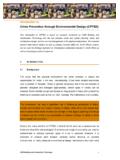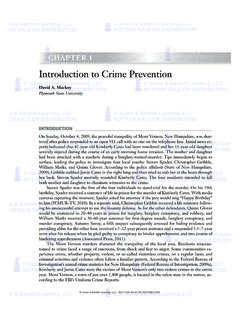Transcription of The Impact of Crime on Business: A Model for …
1 Journal of Management and Marketing Research The Impact of Crime on business , Page 1 The Impact of Crime on business : A Model for Prevention, Detection & Remedy Martin S. Bressler Houston Baptist University Abstract Since the nineteenth century, sociologists have studied the relationship between economic business cycles and increases in Crime . According to the Chamber of Commerce, Crime may be a factor in as many as 30 percent of all business failures. Despite other variables that may contribute to increases in criminal activity, the current economic recession will likely accelerate criminal activity ranging from shoplifting and robbery to fraud and embezzlement. In this paper, the researcher examines the role of prevention and detection of criminal activity and offers prevention as the most cost-effective means to reduce the Impact on business .
2 Keywords: Crime , white collar Crime , Crime prevention Crime cost, Crime Impact Journal of Management and Marketing Research The Impact of Crime on business , Page 2 introduction Economic cycles indicate that during more difficult economic times, criminal activity increases. Experts (Levisohn, 2009) believe that fraud in particular, increases during recessionary times. James Short (1980) compiled a number of comprehensive studies on the relationship between Crime and economic cycles examining a series of studies dating back into the 1800 s. Although numerous variables and circumstances make comparisons difficult, Short concluded that some connection exists. According to the National White Collar Crime Center, the two most recent recessions recorded significant increases of arrests for fraud and embezzlement ( business Week Online, January 12).
3 In 1990, just after the savings and loan crisis, arrests increased 52% and in 2000, after commercial Internet development, arrests increased 25% ( business Week Online, January 12). Arvanites and Defina (2006) examined business Crime activity and economic cycles from 1985 to the early 2000 s and also report a relationship between the two. Businesses, already susceptible to a wide variety of crimes, need to be on their guard to prevent the Impact of criminal activity from impacting profitability to the point that the viability of their business comes into question. Crimes against companies range from shoplifting and vandalism to piracy and counterfeiting. In some instances, crimes committed against businesses are committed by outsiders while in many other situations; employees at all levels commit crimes against their employers.
4 In some cases, companies become unwitting accomplices of money-laundering crimes. Crimes committed against business are nothing new. The literature records numerous examples throughout history. By 1995, the SBCI survey found 35% of retailers reporting customer theft with similar percentages for manufacturing and wholesaling industries. In all, 75% of surveyed businesses reported one or more incidents of Crime , with incidents on average (Burrows & Hopkins, 2005). Small businesses may be particularly vulnerable to Crime as small businesses often do not have safeguards in place to prevent and detect criminal activity. As early as 1996, (prior to Internet Crime ) a survey of 400 firms conducted by the Small business Administration found nearly 13% of surveyed businesses became Crime victims. Further, less than half (48%) employed any security measures and many incidents, especially employee thefts, went unreported (Small business Research Summary, 1997).
5 How much does Crime against business cost? According to the 2007 report Crime in the United States, stolen office equipment alone totaled a staggering $656,982,032. Burglaries on average cost businesses $1,989 and shoplifting which recently increased cost businesses an average $205 per incident. Several recent high-profile cases of fraud include the Madoff investment scandal ($50 billion) and the Stanford investment scandal ($20 billion). Just a few years ago, newspaper headlines shocked readers with news of the Enron and WorldCom financial scandals (Off to Jail, 2005; Schickel, 2005). By 1991, cost estimates of crimes committed against businesses reached $128 billion in direct costs (Thompson et al, 1992). Estimates are difficult to determine as many business crimes go unreported (especially in small businesses) for fear of bad publicity and loss of investor confidence but by 2006, even prior to the current recession, Federal Bureau of Investigation Crime data list the figure at $652 billion annually (cited in Bressler, 2007).
6 Journal of Management and Marketing Research The Impact of Crime on business , Page 3 Literature Review Types of crimes Crimes committed against business can be separated into two categories: those committed by employees against businesses and those committed by others. Table 1 lists some of the more common crimes committed by employees which include theft, fraud, and money laundering. According to Marten and Edwards (2005), three conditions must be present for employees to commit fraud. The first condition is incentive, often in the form of some type of pressure. Pressure may be due to financial reasons, sometimes associated with extra money needed for an adulterous relationship. In other cases, financial pressure could be due to excessive medical bills, gambling debts, or drug addiction. Opportunity exists when businesses fail to develop safeguards or become too trusting of employees.
7 Rationalization occurs when an employee justifies their action as the company owing them . In each of these three conditions, company s management can institute safeguard procedures to reduce the possibility of an employee to use these conditions as an entry to committing fraud. Background and credit checks can identify employees who might be more prone to financial pressures. Fraud hotlines can be established to allow reporting of suspicious employee behaviors, including recent expensive purchases. Opportunity can be lessened when companies develop safeguards through unscheduled audits, use of Accounting Information Systems (AIS) software, and basic procedures such as check approvals. Rationalization may be more difficult to prevent, however, Ethics Statements and management setting good examples may be effective ways to thwart employee rationalization.
8 Embezzlement may perhaps be the most serious Crime impacting business , in that many times the Crime goes undetected for years. Embezzlement affects not only large business but small business , government agencies and non-profit organizations. As so many instances of embezzlement go unreported to police, experts can only estimate the extent of embezzlement activity. Costello (2003) reported that according to an estimate by the National White Collar Crime Center, embezzlement may cost companies as much as $90 billion each year. An employee working at the cafeteria of a state prison in Georgia reportedly skimmed $ million from the cafeteria cash registers over the course of several years (Costello, 2003). In another Georgia case, an employee stole $300,000 worth of postage stamps from the University of Georgia (Costello, 2003).
9 Journal of Management and Marketing Research The Impact of Crime on business , Page 4 Table 1. Typical Crimes Committed by Employees Type of Crime Theft, or skimming of cash Theft of inventory, merchandise or equipment Writing company checks Falsifying revenue reports Processing fraudulent invoices Customer identity theft Money laundering Intellectual property theft Credit card fraud Overstated expense reports Payroll fraud Source: Albrecht et al, 2006 Table 3 highlights some of the more common crimes committed against businesses including vandalism, shoplifting, and theft. Today, however, more businesses fall victim to attack through computer systems. These hack-attacks may take the form of sabotage, customer identity theft, or theft of funds. Since the development of the Internet, cybercrime activity is increasing at an alarming rate.
10 The 1995 National Computer Crime Survey reported 67 percent of the 7,818 businesses surveyed fell victim to at least one cyber attack (Bureau of Justice Statistics, 2008). Many of the cyber attacks involved theft (60%) while other incidents included viruses uploaded to the business computer system. Sixty-eight percent of the cyber attack thefts resulted in a monetary loss of $10,000 or more (Bureau of Justice Statistics, 2008). Yueh (2004) reports businesses suffered a 40% increase in computer attacks over the previous year. The 150,000 computer attacks resulted in a cost to business of $42 billion (Yueh, 2004). Security consultant Richard Stiennon (cited in Elms, et al.) believes cybercrime to be the major threat to computer infrastructure, business processes and businesses themselves. Another study, conducted in 2001 by IDC in Massachusetts, found 95% of IT managers at medium and large companies experienced various computer attacks.














